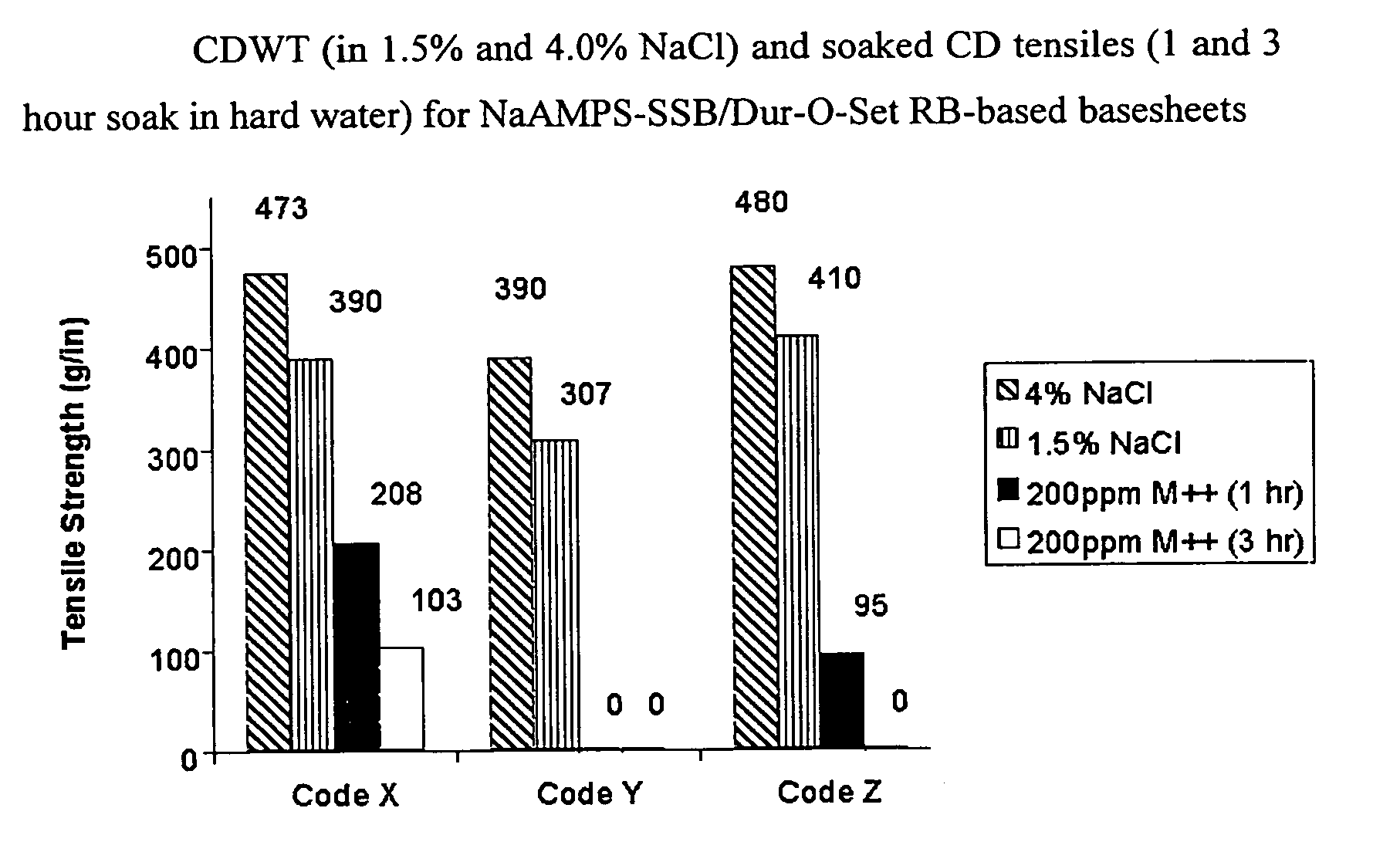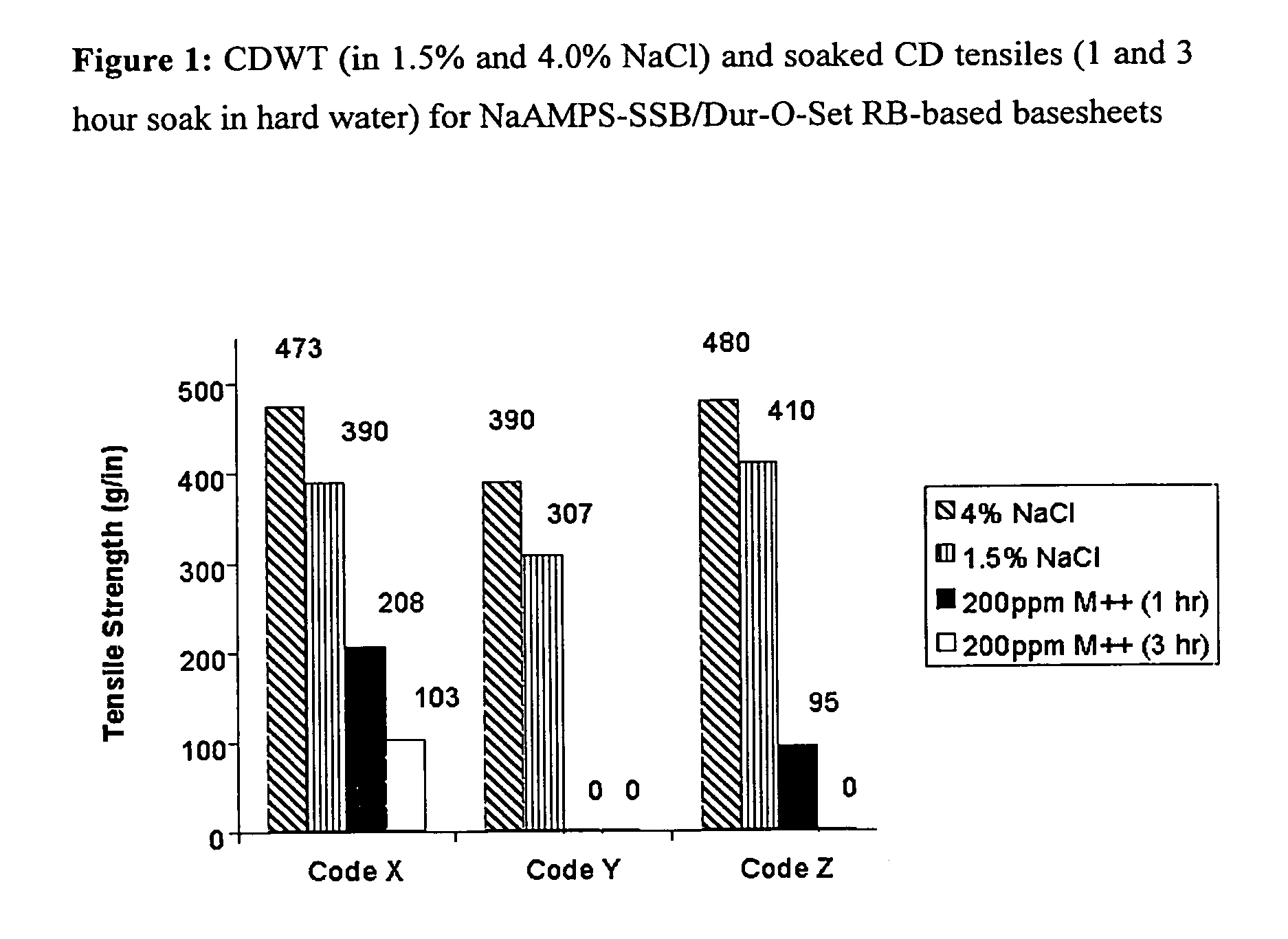Ion-sensitive, water-dispersible polymers, a method of making same and items using same
- Summary
- Abstract
- Description
- Claims
- Application Information
AI Technical Summary
Benefits of technology
Problems solved by technology
Method used
Image
Examples
example 1
Preparation of Sulfonate Anion Modified Acrylic Acid Terpolymer
[0196]Acrylic acid (43.3 g, 0.60 mol), AMPS (10.7 g, 0.052 mol), butyl acrylate (35.2 g, 0.27 mol), and 2-ethylhexyl acrylate (20 g, 0.11 mol) were dissolved in 55 g of acetone / water (70 / 30) mixture. An initiator, 2,2-azobisisobutyronitrile (AIBN) (0.51 g, 3.1× −3 mol), was dissolved in 20 ml of acetone. The monomer solution was deoxygenated by bubbling N2 through the solution for 20 minutes. To a 1000 ml three-neck round bottom flask, equipped with a condenser, two addition funnels and a magnetic stirrer, was added 120 g of an acetone / water (70 / 30) mixture. The solvent was heated to gentle reflux under nitrogen. Monomers and initiator were added simultaneously from the addition funnels over a period of two hours. Polymerization was allowed to proceed for an additional two hours, at the end of which, the addition funnels and condenser were replaced with a distillation head and a mechanical stir rod to remove acetone. A s...
example 2
Preparation of an Acrylic Acid Terpolymer
[0199]An acrylic acid terpolymer was produced using the polymerization procedure outlined in Example 2 of U.S. Pat. No. 5,312,883. The following monomers were used: acrylic acid (50 g, 0.69 mol), butyl acrylate (25 g, 0.20 mol), and 2-ethylhexyl acrylate (25 g, 0.14 mol). The polymer was neutralized with 0.1 mole sodium hydroxide.
example 3
Preparation of Ion-sensitive Polymer Formulation
[0200]The polymers prepared in Table 5, Sample 9 and Example 2 above were combined with Dur-O-Set RB to form the ion-sensitive polymer formulations of the present invention. The polymer formulations were prepared as shown in Table 6 below.
[0201]
TABLE 6Ion-Sensitive Polymer Formulations% Terpolymer% Modified TerpolymerSample(Example 2)(Table 5, Sample 9)% EVA185.00.015.020.085.015.0365.00.035.040.065.035.0595.00.05.060.095.05.0755.00.045.080.055.045.0975.00.025.0100.075.025.0
PUM
| Property | Measurement | Unit |
|---|---|---|
| Length | aaaaa | aaaaa |
| Time | aaaaa | aaaaa |
| Linear density | aaaaa | aaaaa |
Abstract
Description
Claims
Application Information
 Login to View More
Login to View More - R&D
- Intellectual Property
- Life Sciences
- Materials
- Tech Scout
- Unparalleled Data Quality
- Higher Quality Content
- 60% Fewer Hallucinations
Browse by: Latest US Patents, China's latest patents, Technical Efficacy Thesaurus, Application Domain, Technology Topic, Popular Technical Reports.
© 2025 PatSnap. All rights reserved.Legal|Privacy policy|Modern Slavery Act Transparency Statement|Sitemap|About US| Contact US: help@patsnap.com



